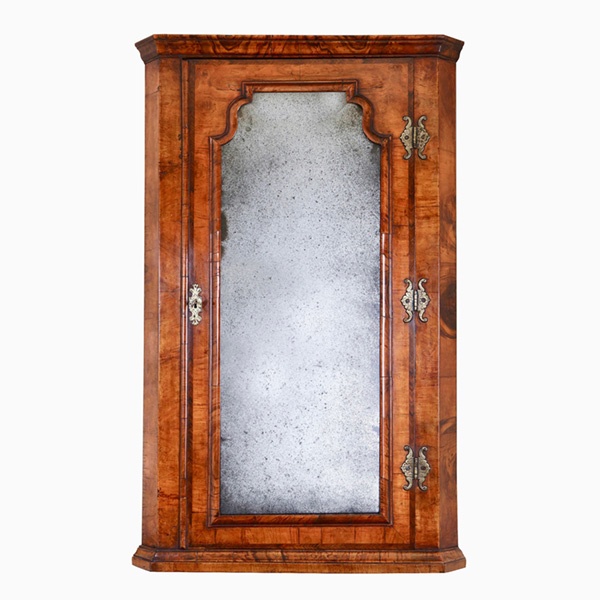A Fine and Rare Three Part George I Burr Walnut Bureau Bookcase, Circa 1720-1730. England
Sold
Follow Us
A Fine and Rare Three Part George I Burr Walnut Bureau Bookcase, Circa 1720-1730. England
Attributed to Coxed and Woster (1700-1735)
A fine George I burr walnut feather banded bureau bookcase consisting of three sections, the chest, bureau and bookcase. The bookcase is surmounted with a cavetto moulded cornice above a pair of inset moulded and shaped mirrored doors opening to reveal an arrangement of fitted double D-moulded shelves. Retractable candle slides are positioned at the base of each mirrored door.
The bureau, with applied cross-grain ogee-moulded bookrest, supported by retractable lopers divided by two short oak lined feather banded drawers, each fitted with the original gilt-brass ring-pull handles, oval escutcheons and locks. The cross-grain moulded feather-banded fall opens to reveal what is possibly the original inset leather writing surface in front of an arrangement of pigeon holes, small and long feather-banded drawers, each fitted with the original knobs. To the centre is a feather-banded cupboard between Tuscan columns concealing three hidden drawers.
The ovolo waist moulded chest is raised on ball and bracket feet. It is fitted with three graduating oak-lined feather-banded drawers, each fitted with the original gilt-brass ring pull handles, oval escutcheons and locks.
A truly rare and superb quality piece, with choice use of quality burr veneers throughout its construction.
Literature. Coxed and Woster was a partnership formed after the death of John Coxed. In his will, John left instructions for his widow, Grace, to ‘go partners’ with his brother-in-law, Thomas Woster, who was also a cabinet maker. Grace Coxed was married and widowed twice, both husbands being cabinet makers. Her first marriage was to John Mayo, who at his death left his business in the hands of his widow Grace. One of Mayo’s apprentices was John Coxed, who completed his term of indenture under Grace’s supervision on 7 September 1703. Grace managed her cabinet making business after her first husband’s death for seven years before she married John Coxed in 1707. They were married married for ten years until his death in November 1718.
Grace’s role in the business is unknown: there are no records of her activity in London Companies, or accounts of her business transactions, but she was presumably involved in running the cabinet making firm, Coxed and Woster from her second husband’s death in 1718 until she died in 1735.
A number of desks, bureaux, bureau cabinets, secretaire cabinets and chests of drawers dating from the period 1720–35 have been found with the trade labels G. Coxed & T. Woster (e.g. Colonial Williamsburg). Typically, they are veneered in walnut or burr maple and some pieces are embellished with rosewood crossbanding and pewter stringing. The fullest known trade label reads ‘G.Coxed and T.Woster At the White Swan, against the South-Gate in St Paul’s Church Yard, London, Makes and Sells Cabinets, Scrutoires, Desks and Book-Cases, Buro’s Chests of Drawers, Wisk, Ombre, Dutch and Indian Tea-Tables; All sorts of Looking-Glasses, Large Sconces, Dressing Sets and Wainscot-Work of all sorts, at Reasonable Rates. Old Glasses New polished and Made up fashionable.’
Condition
Good. Wear consistent with age and use.
Dimensions
Height: 226 cm / 89 Inches
Width: 103 cm / 40 1/2
Inches Depth: 60 cm / 23 1/2 Inches
PREVIOUSLY SOLD
No Results Found
The page you requested could not be found. Try refining your search, or use the navigation above to locate the post.
No Results Found
The page you requested could not be found. Try refining your search, or use the navigation above to locate the post.
YOU MAY ALSO LIKE

Queen Anne Walnut Corner Cupboard with Bevelled Mirror Plate
A truly remarkable find in original condition. To the door a shaped soft bevelled mirror plate is framed by a cross-grain molding of typical queen Anne design which is further cross-banded, feather-banded and edged to the opening with a single de-molding.

Queen Anne Walnut Corner Cupboard with Bevelled Mirror Plate
A truly remarkable find in original condition. To the door a shaped soft bevelled mirror plate is framed by a cross-grain molding of typical queen Anne design which is further cross-banded, feather-banded and edged to the opening with a single de-molding.

















